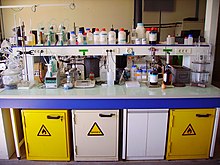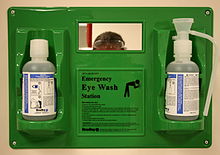| Revision as of 11:37, 4 June 2015 editTatiana1112 (talk | contribs)20 edits →Equipment: removed tag and put in references← Previous edit | Revision as of 11:40, 4 June 2015 edit undoTatiana1112 (talk | contribs)20 editsm →Equipment: new referencesNext edit → | ||
| Line 30: | Line 30: | ||
| Laboratory equipment refers to the various tools and equipment used by scientists working in a laboratory. These include tools such as ]s, and ]s as well as specialty equipment such as ]s, ]s and ]s. Another important type of laboratory equipment is ] such as the ] or ], or even a ]. | Laboratory equipment refers to the various tools and equipment used by scientists working in a laboratory. These include tools such as ]s, and ]s as well as specialty equipment such as ]s, ]s and ]s. Another important type of laboratory equipment is ] such as the ] or ], or even a ]. | ||
| Laboratory equipment is generally used to either perform an ] or to take ]s and gather ]. Larger or more sophisticated equipment is generally called a ]. Both laboratory equipment and scientific instruments are increasingly being designed and shared using ] principles.<ref>Pearce, |
Laboratory equipment is generally used to either perform an ] or to take ]s and gather ]. Larger or more sophisticated equipment is generally called a ]. Both laboratory equipment and scientific instruments are increasingly being designed and shared using ] principles.<ref>Pearce, J.M., 2014. . ''Nature'' '''505''', 618. doi:10.1038/505618d</ref>Baden, T., Chagas, A. M., Gage, G., Marzullo, T., Prieto-Godino, L. L., & Euler, T. (2015). Open Labware: 3-D Printing Your Own Lab Equipment. PLOS Biology, 13(3). DOI: 10.1371/journal.pbio.1002086 http://journals.plos.org/plosbiology/article?id=10.1371/journal.pbio.1002086</ref> | ||
| ==Specialised types== | ==Specialised types== | ||
Revision as of 11:40, 4 June 2015
For other uses, see Laboratory (disambiguation).| This article needs additional citations for verification. Please help improve this article by adding citations to reliable sources. Unsourced material may be challenged and removed. Find sources: "Laboratory" – news · newspapers · books · scholar · JSTOR (July 2007) (Learn how and when to remove this message) |




A laboratory (/ləˈbɒrətəri/ or /ˈlæbərətri/; informally, lab) is a facility that provides controlled conditions in which scientific or technological research, experiments, and measurement may be performed.
Laboratories used for scientific research take many forms because of the differing requirements of specialists in the various fields of science and engineering. A physics laboratory might contain a particle accelerator or vacuum chamber, while a metallurgy laboratory could have apparatus for casting or refining metals or for testing their strength. A chemist or biologist might use a wet laboratory, while a psychologist's laboratory might be a room with one-way mirrors and hidden cameras in which to observe behavior. In some laboratories, such as those commonly used by computer scientists, computers (sometimes supercomputers) are used for either simulations or the analysis of data collected elsewhere. Scientists in other fields will use still other types of laboratories. Engineers use laboratories as well to design, build, and test technological devices.
Despite the great differences among laboratories, some features are common. The use of workbenches or countertops at which scientists may choose to either sit or stand is a common way to ensure comfortable working conditions. Cabinets for the storage of laboratory equipment are also found in laboratories. It is traditional for a scientist to record an experiment's progress in a laboratory notebook, but modern labs almost always contain at least one computer workstation for data collection and analysis.
Scientific laboratories can be found in schools and universities, in industry, in government or military facilities, and even aboard ships and spacecraft. A laboratory might offer work space for just one to more than thirty researchers depending on its size and purpose. Recently, a new type of laboratory called Open Laboratory has emerged. Its format allows the sharing of space, equipment, support staff between different research groups and also fosters information exchange through communications across fields. There is also an open source lab, which is a lab that is made up of open source scientific hardware.
History
| This section needs expansion. You can help by adding to it. (February 2013) |
-
 Chemistry laboratory of the 18th century, of the sort used by Antoine Lavoisier and his contemporaries
Chemistry laboratory of the 18th century, of the sort used by Antoine Lavoisier and his contemporaries
-
 Thomas Edison in his laboratory, 1901
Thomas Edison in his laboratory, 1901
-
 A laboratory in the 1970s
A laboratory in the 1970s
Techniques
Laboratory techniques are the sum of procedures used on natural sciences such as chemistry, biology, physics in order to conduct an experiment, all of them follow scientific method; while some of them involves the use of complex laboratory equipment from laboratory glassware to electrical devices others require such specific or expensive supplies.
Equipment

Laboratory equipment refers to the various tools and equipment used by scientists working in a laboratory. These include tools such as Bunsen burners, and microscopes as well as specialty equipment such as operant conditioning chambers, spectrophotometers and calorimeters. Another important type of laboratory equipment is laboratory glassware such as the beaker or reagent bottle, or even a thermometer.
Laboratory equipment is generally used to either perform an experiment or to take measurements and gather data. Larger or more sophisticated equipment is generally called a scientific instrument. Both laboratory equipment and scientific instruments are increasingly being designed and shared using open hardware principles.Baden, T., Chagas, A. M., Gage, G., Marzullo, T., Prieto-Godino, L. L., & Euler, T. (2015). Open Labware: 3-D Printing Your Own Lab Equipment. PLOS Biology, 13(3). DOI: 10.1371/journal.pbio.1002086 http://journals.plos.org/plosbiology/article?id=10.1371/journal.pbio.1002086</ref>
Specialised types
The title of laboratory is also used for certain other facilities where the processes or equipment used are similar to those in scientific laboratories. These notably include:
- film laboratory or darkroom
- clandestine lab for the production of illegal drugs
- computer lab
- crime lab used to process crime scene evidence
- media lab
- medical laboratory (involves handling of chemical compounds)
- public health laboratory
In recent years government and private centers for innovation in learning, leadership and organization have adopted "lab" in their name to emphasize the experimental and research-oriented nature of their work.
Safety
Main article: Laboratory safety
In some laboratories, the conditions are no more dangerous than in any other room. In many labs, though, hazards are present. Laboratory hazards are as varied as the subjects of study in laboratories, and might include poisons; infectious agents; flammable, explosive, or radioactive materials; moving machinery; extreme temperatures; lasers, strong magnetic fields or high voltage. In laboratories where dangerous conditions might exist, safety precautions are important. Rules exist to minimize the individual's risk, and safety equipment is used to protect the lab user from injury or to assist in responding to an emergency.
The Occupational Safety and Health Administration (OSHA) in the United States, recognizing the unique characteristics of the laboratory workplace, has tailored a standard for occupational exposure to hazardous chemicals in laboratories. This standard is often referred to as the "Laboratory Standard". Under this standard, a laboratory is required to produce a Chemical Hygiene Plan (CHP) which addresses the specific hazards found in its location, and its approach to them.
In determining the proper Chemical Hygiene Plan for a particular business or laboratory, it is necessary to understand the requirements of the standard, evaluation of the current safety, health and environmental practices and assessment of the hazards. The CHP must be reviewed annually. Many schools and businesses employ safety, health, and environmental specialists, such as a Chemical Hygiene Officer (CHO) to develop, manage, and evaluate their CHP. Additionally, third party review is also used to provide an objective "outside view" which provides a fresh look at areas and problems that may be taken for granted or overlooked due to habit.
Inspections and audits like also be conducted on a regular basis to assess hazards due to chemical handling and storage, electrical equipment, biohazards, hazardous waste management, chemical waste, housekeeping and emergency preparedness, radiation safety, ventilation as well as respiratory testing and indoor air quality. An important element of such audits is the review of regulatory compliance and the training of individuals who have access to and/or work in the laboratory. Training is critical to the ongoing safe operation of the laboratory facility. Educators, staff and management must be engaged in working to reduce the likelihood of accidents, injuries and potential litigation. Efforts are made to ensure laboratory safety videos are both relevant and engaging.
See also
- Chemical accident
- Contamination control
- Controlled lab reactor
- Environmental health
- Fume hood to limit exposure to hazardous or toxic fumes, vapors or dusts
- Hackspace
- ISO/IEC 17025
- Lab website
- Laboratory safety
- Workshop
References
- Joshua M. Pearce,Open-Source Lab:How to Build Your Own Hardware and Reduce Research Costs, Elsevier, 2014. ISBN 9780124104624
- Joshua M. Pearce, “Building Research Equipment with Free, Open-Source Hardware.” Science 337 (6100): 1303–1304 (2012).
- Pearce, J.M., 2014. Laboratory equipment: Cut costs with open-source hardware. Nature 505, 618. doi:10.1038/505618d
- Michael L. Matson, Jeffrey P. Fitzgerald, Shirley Lin (October 1, 2007). "Creating Customized, Relevant, and Engaging Laboratory Safety Videos". Journal of Chemical Education. 84 (10): 1727. Bibcode:2007JChEd..84.1727M. doi:10.1021/ed084p1727. Retrieved 22 February 2013.
{{cite journal}}: CS1 maint: multiple names: authors list (link)
External links
 The dictionary definition of laboratory at Wiktionary
The dictionary definition of laboratory at Wiktionary Media related to Laboratory at Wikimedia Commons
Media related to Laboratory at Wikimedia Commons- Nobel Laureates Interactive 360° Laboratories
| Laboratory equipment | |||||||||||||||||||||||
|---|---|---|---|---|---|---|---|---|---|---|---|---|---|---|---|---|---|---|---|---|---|---|---|
| |||||||||||||||||||||||
| |||||||||||||||||||||||
| |||||||||||||||||||||||
| |||||||||||||||||||||||
| |||||||||||||||||||||||
| Instruments used in medical laboratories | |||||||||||||||||||||||